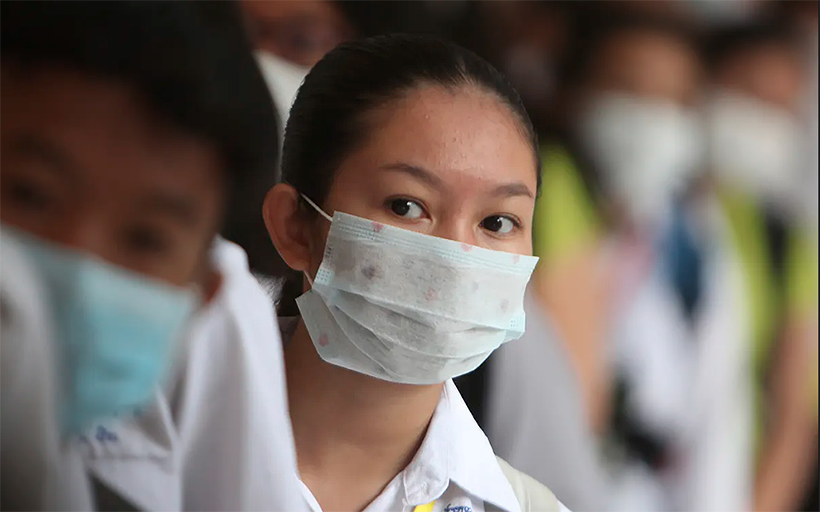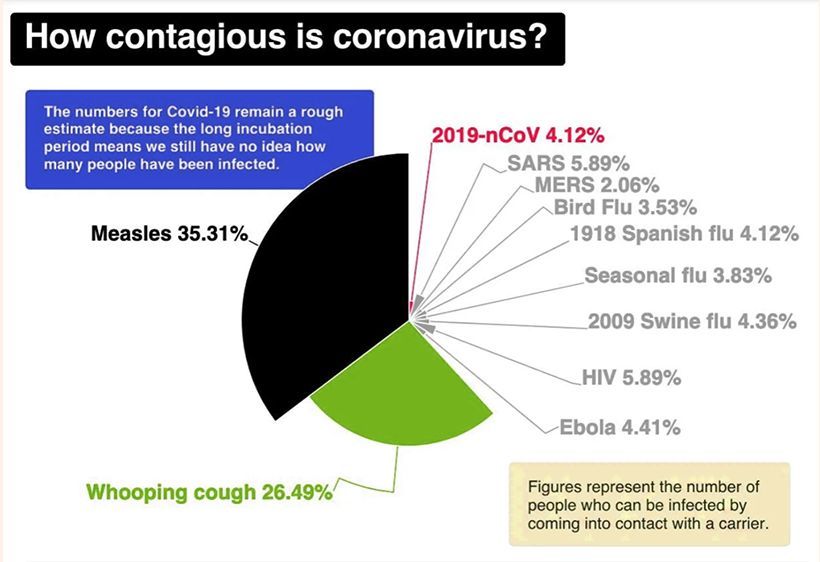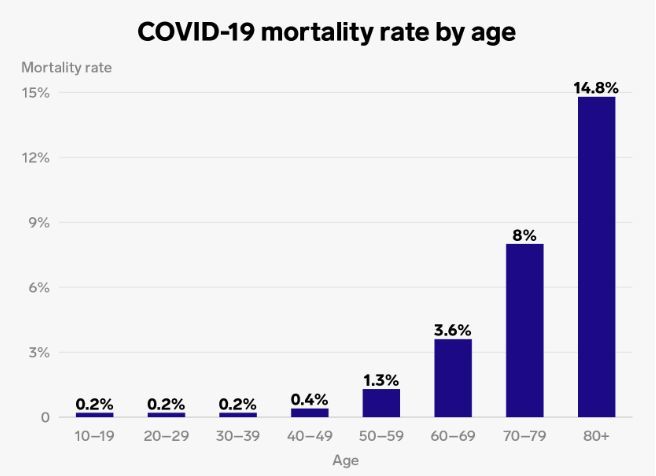Reasons you should take Covid-19 seriously – symptoms and prevention

Viruses are designed to survive, evolve and thrive. The insidious beauty of the Covid-19 virus is that the symptoms in its human hosts can remain dormant for up to 14 days (or so), during which time the host can be highly contagious, milling around in close contact with other humans, oblivious to their role as a ‘spreader’.
As of this morning the number of cases of the Covid-19 coronavirus has reached 110,087. The number of deaths related to the virus is now 3,831, representing a death rate of around 3.4%, up from the earlier days when it hovered around 2%. But the number of people that have fully recovered has now grown to 62,301.
(SOURCE: worldometers.info)
A few key points have emerged from the two months of accumulated data on the novel coronavirus that deserve our attention.
Firstly, the virus is at least AS contagious as most other coronaviruses, whilst the death rate is currently higher than the more common seasonal flus. A lot higher. Like 60 times higher (when compared to annual US influenza stats). Statistically that isn’t hugely significant when there are 100,000 cases. But it would be if there were 100 million, or a billion cases.
“So far, the new coronavirus has led to more than 100,000 illnesses and more than 3,000 deaths worldwide. But that’s nothing compared with the flu, also called influenza. In the U.S. alone, the flu has caused an estimated 32 million illnesses, 310,000 hospitalisations and 18,000 deaths this season, according to the US Centres for Disease Control and Prevention.” – LiveScience.com
Influenzas are already global and have been floating around the global community for thousands of years, mutating and evolving. Covid-19 has been around for little over 2 months, and only a month or so beyond China’s borders (in any significant numbers).

Still, the ability for governments, generally, to contain the spread of the disease has been swift at this stage and the education about prevention continues spread quickly through the internet (as does the misinformation).
“The World Health Organisation mission to China found that 78% of the cases reported as of February 20 were in people ages 30 to 69.” – StatNews.com
It should also be noted that many of the people who have sadly succumbed to the virus have been in the older demographics, in China and beyond, and many with reported underlying diseases as well. In fact, as you get older your chances of dying from a Covid-19 infection increases, in a completely predictable linear fashion. The message here is clear – be young and remain healthy.

• Symptoms and prevention (below)
Secondly, we are in the very early phases of this new viral outbreak. Whilst the containment has been swift, and with many locations (around Hubei province in China, towns of Northern Italy and central South Korea) in almost total lockdown, we’re still seeing a growth and spread of the virus.
The World Health Organisation hasn’t uttered the ‘P’ word yet, but it would be realistic to describe the current outbreak moving in the direction of a global pandemic – Covid-19 has now been reported in 96 countries around the world.
pandemic – the spread (of a disease) prevalent over a whole country or the world
The situations in northern Italy, central South Korea and Iran in recent weeks are likely to pop up in other locations as well. Meanwhile, the WHO yesterday issued their statement that the current situation “is not a drill” and urged governments around the world to take the situation more seriously. It’s not as if there is a plateauing of the ‘new cases’ or ‘deaths’ graph anytime in the past two months.
It’s also clear that our mobile, jet-setting lifestyle – more people are flying from continent to continent than any time in human history – is helping to spread the disease, faster and more efficiently.

Thirdly, there is still much we don’t understand about the novel coronavirus. As its original designation suggests, it’s novel, or new. New information, scientifically verified, is creeping out each day giving global authorities better information to initiate better procedures to reduce the spread and care for the patients.
That all bodes well for the future although, at this stage, the increased knowledge hasn’t turned into a drop in the numbers of new reported cases. Responsible media remains core to communicating the latest, most accurate information.
Finally, the virus’s incubation period, where it can remain contagious with the carrier showing few or no symptoms, is an ongoing concern.
Viruses are designed to survive, evolve and thrive. The insidious beauty of the Covid-19 virus is that the symptoms in its human hosts can remain dormant for up to 14 days (or so), during which time the host can be highly contagious, milling around in close contact with other humans, oblivious to their role as a ‘spreader’.
This relatively unique dynamic of the novel virus will continue to remain the virus’s main advantage, and the biggest challenge for world health authorities.
So, why should we be taking the Covid-19 outbreak seriously?
In the next few months there will surely be some reliable, proven vaccine produced. But it could take up to a year, or more, to test it and then ramp up the manufacture to a point where medical authorities could usefully start vaccinating large sections of the community. Even so, the early days of manufacture will be used on the most serious cases, in the richest countries. It’s roll-out to a wider world population could take many more months.
Add to this the level of anti-vax sentiment and misinformation, especially in the US, and you don’t have a perfect solution with a new vaccine either. Impoverished communities around the world will likely remain vulnerable.
If, and it’s only an ‘if’ at this stage, the Covid-19 does become ‘global’ and widespread, then the best long term solution is going to be preventative which will fundamentally change so many aspects of our lives, compared to the pre-coronavirus days (pre-2020).
Travel, events, gatherings of people, greetings, wearing of face-masks (whether they provide any barrier or not), tourism industry, business sentiment, etc, etc. Things will change and a new post-Covid-19 world may emerge, where our community and contact with each other may be played out in a whole new way; the hand shake, the cheek-kiss greeting of the Europeans, protocols at large events.
The sorts of panic situations we’re seeing now (I’m thinking Australians and the mad panic on toilet-roll hoarding, for example) will abate but will become replaced with new general behaviours which will profoundly change the way we communicate and go about civil discourse.
The big winners will be some medical companies and private hospitals, delivery services, businesses that can operate with its workforce working remotely, and probably a few churches. There will also be a boom in fake-cures, pseudoscience-related information, scams and politicians who will use the turn of events to their own benefit. Turn your bullshit-detector dial up to ‘high’.

So when people post about world influenza figures, compare the Covid-19 outbreak to the issue of global starvation or even the road toll, they forget that ALL these issues are separate and unique situations that bear no resemblance. The issues should not, and cannot, be compared. Yes, the message should be “don’t panic” and “coronavirus hasn’t killed millions”. But statistical comparisons with other things that might kill you are illogical internet memes and not much more.
We remain floundering in the very early days of this current outbreak and, statistically, there are no positive signs of the situation being brought under control in the immediate future.
“We are in unchartered territory. We have never before seen a respiratory pathogen that is capable of community transmission, but which can also be contained with the right measures.” – WHO Chief
Remain alert and informed, but not alarmed.
Symptoms
Symptoms of Covid-19 are similar to a range of other illnesses such as influenza. Having any of these symptoms does not necessarily mean that you have Covid-19, and in the vast majority of cases, it won’t be. But symptoms include…
- fever
- coughing
- difficulty breathing
Difficulty breathing is a sign of possible respiratory problems, a lung infection or pneumonia and requires immediate medical attention.
We don’t yet know how long symptoms take to show after a person has been infected, but current World Health Organisation assessments suggest that it is 2–10 days, even up to 14 days.
If you have these symptoms, or have recently been to a country or area of concern, or have been in close contact with someone confirmed with Covid-19, or in an area with a lot of other people, please contact your nearest public hospital to register your situation, and go to the hospital if you start to display symptoms.
Prevention
There is currently no vaccine to prevent the latest coronavirus (Covid-19). The best way to prevent illness is to avoid being exposed to this virus. However, here are some everyday preventive actions to help prevent the spread of respiratory diseases, including:
- Avoid close contact with people who are sick
- Avoid touching your eyes, nose, and mouth
- Stay home when you are sick
- Cover your cough or sneeze with a tissue, then throw the tissue in the rubbish bin
- Clean and disinfect frequently touched objects and surfaces using a regular household cleaning spray or wipe
- Follow medical recommendations for using a face mask…
- The US Centres for Disease Control and the World Health Organisation do not recommend that people who are well wear a face mask to protect themselves from respiratory diseases, including Covid-19.
- Face masks should be used by people who show symptoms of Covid-19 to help prevent the spread of the disease to others. The use of face masks is also crucial for health workers and people who are taking care of someone in close settings (at home or in a health care facility)
- Wash your hands often with soap and water for at least 20 seconds, especially after going to the bathroom; before eating; and after blowing your nose, coughing, or sneezing.
- If soap and water are not readily available, use an alcohol-based hand sanitiser with at least 60% alcohol
- Always wash hands with soap and water if hands are visibly dirty
Latest Thailand News
Follow The Thaiger on Google News:


























